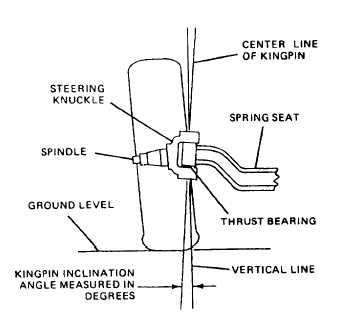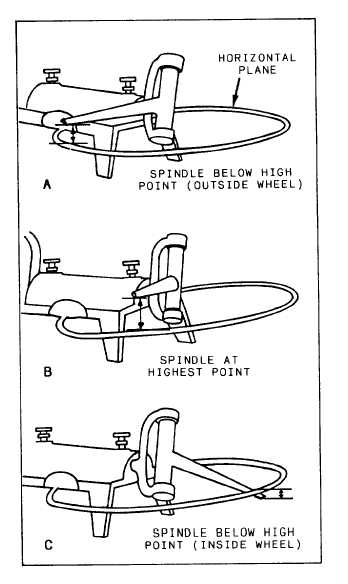
Figure 12-3. - Kingpin inclination.
independent suspension, the upper pivot point (ball joint) is set to the rear of the lower pivot point.
Caster is a directional control angle, but not a tire wearing angle. Positive caster causes the vehicle to steer in the direction in which it is moving. This is called an automatic steering effect; for instance, the forward momentum of a vehicle tends to keep wheels with positive caster in the straight-ahead position. After rounding a turn, this causes the wheels to return to a straight-ahead position when the driver releases the steering wheel. This automatic steering effect is also called self-righting or self-centering action.
Positive caster makes the turning of the steering wheel more difficult, whereas negative caster turns more easily, but will cause the vehicle to wander.
3. KINGPIN INCLINATION. The inward tilt of the kingpin at the top is known as kingpin inclination (KPI). KPI (fig. 12-3) is measured in degrees from the center line of the ball joint or kingpin to true vertical (0). It is a directional control angle with fixed relationship to camber settings. It is also nonadjustable. One purpose of this inclination is to reduce the need for excessive camber. Figure 12-4 shows a dead axle with fixed KPI. The angle of the kingpin and spindle is made extreme to clarify the principles involved.
Timing the wheels to the left or right revolves the spindles around the kingpin. As the spindle is moved to the left or right from the position shown in figure 12-4, B, its end moves down, as shown in figure 12-4, A and

Figure 12-4. - Fixed KPI.
C. Thus, as the front wheels turn, the spindle will attempt to move down from the high point. Since the wheels and tires prevent the spindles from moving down, the axle is raised. This action tends to raise the front of the vehicle. As the turning force is removed from the wheels, the weight of the vehicle helps force the wheels back to the straight-ahead position.
Vehicles with ball-joint suspension have what is known as steering axis inclination (SAI) which is defined as the inward tilt of the spindle support arm at the top. The spindle assembly is supported at the upper and lower control arms by ball joints. The pivoting axis of the wheel around the ball joints is the same as the kingpin axis of vehicles with dead axles.
4. TOE-IN. This is the distance between the front of the front wheels as compared to the distance at the
Continue Reading